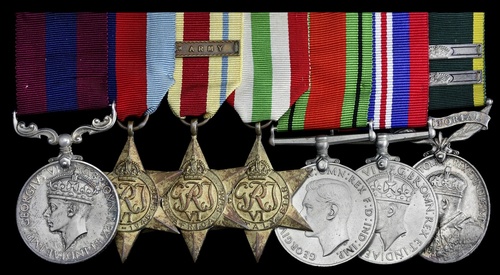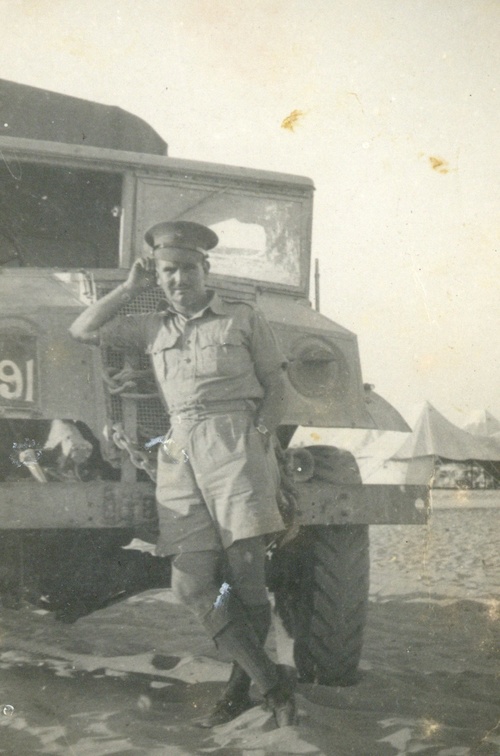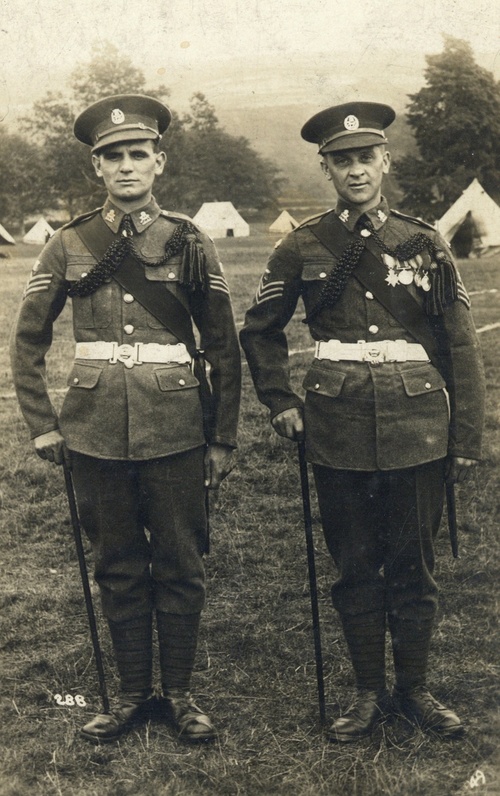Auction: 18003 - Orders, Decorations and Medals
Lot: 596
An outstanding Second World War Desert Rat's immediate D.C.M. group of seven awarded to Company Sergeant-Major T. A. Mattock, East Yorkshire Regiment, late York & Lancaster Regiment (Territorials)
He was recommended 'for the highest possible award' after displaying magnificent courage in taking out two enemy machine-gun posts on the Gazala line in June 1942, the second of them after being wounded in the face, neck and arm by a Breda bomb
Distinguished Conduct Medal, G.VI.R. (4739803 W.O. Cl. II T. A. Mattock, E. York R.); 1939-45 Star; Africa Star, clasp, 8th Army; Italy Star; Defence and War Medals 1939-45; Efficiency Medal, G.V.R., robed bust, Territorial, with 2 Bars (4739803 Pte. T. Mattock, 5-Y. & L.R.), mounted as worn, minor official correction to surname on the last, generally good very fine (7)
D.C.M. London Gazette 24 September 1942. The original recommendation states:
'Company Sergeant-Major T. A. Mattock is the C.S.M. of 'B' Company, 5th Battalion, The East Yorkshire Regiment.
On the evening of 14 June 1942, during the withdrawal from the Gazala line in Libya, the C.S.M. went into the attack on the Company P.U. with 'B' Company as spearhead company.
When the smoke of the shell fire and the dust of the tanks cleared away, the P.U. was about 150 yards away from a Breda and Reville machine-gun nest. There was a similar nest in the rear. The P.U. was hit by an anti-tank shell and set ablaze and this brought fire from the two nests and, for some time, owing to the heavy and intense fire, the personnel of the P.U. were unable to move. However, when it was dark, this C.S.M. went to fetch up the rest of the Company on to their objective but was fired on from 150 yards away. He went in with a private soldier to clear up the post but the soldier was mortally wounded before they made contact. Although only armed with a rifle and some hand grenades, the C.S.M. went on alone, accounted for his men and smashed up the guns by firing into the locks. He then went to clear the nest in the rear, which was pinning down the Company. Although he was wounded about the neck, shoulders and face, he carried on and accounted for his men with hand grenades and brought back a prisoner who tried to stop him. He was then pinned down by our own barrage for at least two hours. It had been opened up to support the spearhead company, the support group not knowing that the way had been made clear by the C.S.M.'s brilliant actions.
He was then put on a carrier and he brought through the "gap" a number of transport vehicles which were lost; he brought them to the Egyptian border without the loss of one vehicle, using the stars as his guide in navigation.
His actions on 28 June 1942 were also commendable. He took over the duties of Company Commander, since his own commander was acting as navigator to the composite battle group which 'B' Company was part of. During his time in this capacity he brought the Company through heavy anti-tank fire without loss to a single vehicle. At times he was going up and down the column on foot, giving directions and attack instructions to his men, also cheering them by his own good spirits and disregard for his own safety.
He is recommended for the highest possible award.'
The recipient's copy of this citation, typed on vellum and presented to him by his C.O. at the time of submission to Brigade level, is included. It is far more extensive than the recommendation for an immediate D.C.M. that was eventually signed off by the 'Auk' and is a fascinating insight into the submission of original battlefield recommendations; the cataloguer has amended punctuation.
Thomas Arthur Mattock was born at Daventry, Northamptonshire in January 1906 and enlisted as a boy recruit in the York & Lancaster Regiment (Territorials) in July 1921, the same month in which he was posted to the 5th Battalion. Having then served as a Drummer and been advanced to Lance-Corporal, he was discharged on the termination of his period of engagement in July 1936; according to a family source, 'he was very musical, having played in a dance band and played piano for the silent movies.'
In July 1939, Mattock re-enlisted in the Territorials, this time as a soldier of the 5th Battalion, East Yorkshire Regiment. He was immediately appointed to the rank of Sergeant and Drum Major and served with the B.E.F. in Belgium and France in the period May-June 1940.
Advanced to C.Q.M.S. on his return to the U.K. following Operation "Dynamo", he was embarked for the Middle East in November 1941 and, following postings to Iraq and Palestine, went into action with as a C.S.M. in the Western Desert in February 1942. Here, then, the scene of his subsequent gallantry on the Gazala line that June, when he was recommended 'for the highest possible award.'
Following further active service in Italy, Mattock returned to the U.K. in early 1944 and ended the war with an appointment at 182 P.O.W. Base Camp in Scotland. On his discharge to the Army Reserve in December 1945, he set up a building business. This was sold in 1960, owing to ill-health, and he died at Hornsea, East Yorkshire in January 1970.
Sold with a quantity of original documentation, including a pass issued at 182 P.O.W. Base Camp in June 1945, two photographs of the recipient in uniform and assorted certificates relating to his membership of the Royal Order of the Buffaloes (R.A.O.B.); together with R.A.O.B. Edinburgh, Llandudno and London convention badges and a related R.A.O.B. 'Roll of Honour' jewel, silver-gilt, the reverse engraved, 'Bro. T. A. Mattock, Good Fellowship, Lodge No. 1256, Exalted, 15.9.69'.
Subject to 20% VAT on Buyer’s Premium. For more information please view Terms and Conditions for Buyers.
Sold for
£3,200









